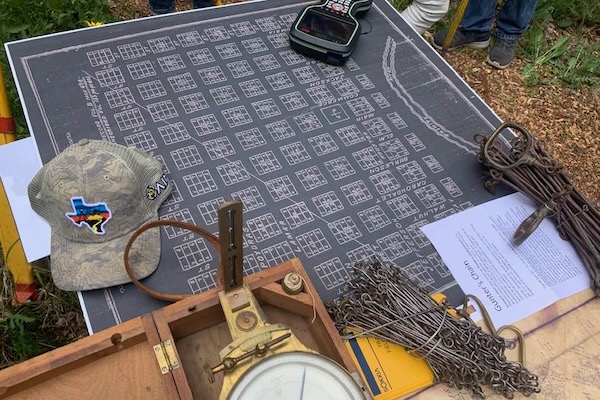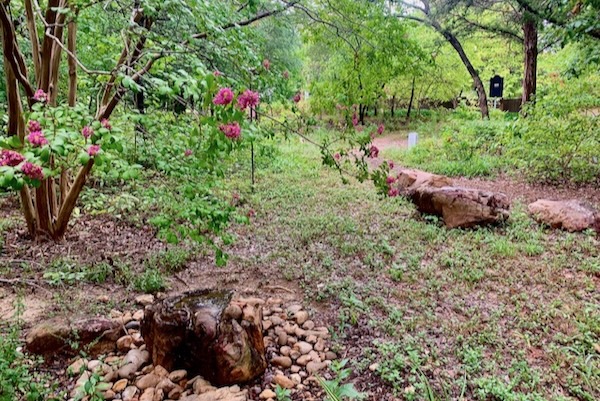
A historical marker designates Warren Ferris Cemetery in Dallas. Courtesy of Friends of Warren Ferris Cemetery.
Oct. 27, 2023
Eight historical cemeteries in Dallas will soon be resurrected into the beautifully natural memorials that they were when they were founded.
Over the course of two years, the aging graveyards will be turned from rows of common plots into native, bucolic settings, which organizers hope will not only support wildlife but serve as a place of respite for the urbanites who live nearby.
The restoration project is part of a two-year pilot program called the Constellation of Living Memorials initiated by the Friends of Warren Ferris Cemetery.
As funding is secured, volunteers will replace bare ground, exotic privet and weekly-mowed Bermuda and Saint Augustine turf with permanent evergreen hedge rows, wildflowers and native grasses. As a result, the cemeteries should incur lower maintenance costs while serving as pollinator habitat, wildlife refuge and added green space along a 10-mile span from Oak Cliff to far East Dallas.
The project aims to bring together people from throughout the community to set a new standard for historical cemeteries and transition them into educational resources and spaces to enjoy throughout the seasons.
The eight cemeteries enrolled in the program are: W.W. Glover Cemetery, Oak Cliff Cemetery, Persimmon Road Cemetery, Santo de Cemento Cemetery, Albert Carver Cemetery, Oakland Cemetery, Beeman Cemetery and Western Heights Cemetery.
The graveyards were all built by pioneers to the area. Persimmon Road Cemetery is an African American historic site that dates back to the era prior to the Civil War in the vicinity of Dallas’ Five Mile Creek.
BUILDING ON SUCCESS
 Constellation of Living Memorials Community Director Ebony Brock, left, and Julie Fineman, Friends of Warren Ferris Cemetery founder, display a map of historic cemeteries in Texas, which they hope can be transformed into a network of rewilded spaces. Courtesy of Friends of Warren Ferris Cemetery.
Constellation of Living Memorials Community Director Ebony Brock, left, and Julie Fineman, Friends of Warren Ferris Cemetery founder, display a map of historic cemeteries in Texas, which they hope can be transformed into a network of rewilded spaces. Courtesy of Friends of Warren Ferris Cemetery.
The all-volunteer group spearheading the project has already accomplished a similar transformation of the Warren Angus Ferris Historical Cemetery in East Dallas. The cemetery serves as the final resting place of many of the city’s earliest pioneers. Now the group seeks to extend its vision for the restoration of historical cemeteries to grave sites throughout the state, and eventually throughout the nation.
Now the group seeks to extend its vision for the restoration of historical cemeteries to grave sites throughout the state, and eventually throughout the nation.
Friends of Warren Ferris Cemetery founder Julie Ann Fineman says all of the eight cemeteries enrolled in the program are within a 10-minute walk of local bike trails and hiking paths.
“We want to create more of an enticement to invite people to come and see these cemeteries in their current state and to watch what happens to them through the two-year pilot program in which we're going to be restoring a part of, if not all, of the land in the cemeteries back into native wildlife habitat as a means of honoring those who are buried there.”
COLLABORATION
Fineman says she’s working with the North Texas chapter of the Texas A&M Master Naturalist program to adopt the pilot project as part of the chapter’s yearly community outreach and volunteer requirement for its participants.
The creation of the Constellation of Living Memorials project itself is a collaboration of several volunteers, including Kim Conrow of the Native Plant Society of Texas, former State Representative Harryette Ehrhardt, and Kathy Ann Reid who serves on the cemetery committee of the Dallas County Pioneers Association.
 Old survey equipment possibly used by Warren Ferris himself over an old map of Dallas. Ferris was the first person to survey Dallas when it was just Blackland Prairies broken up by woodlands along the waterways of creeks and rivers. Courtesy of Friends of Warren Ferris Cemetery.
Old survey equipment possibly used by Warren Ferris himself over an old map of Dallas. Ferris was the first person to survey Dallas when it was just Blackland Prairies broken up by woodlands along the waterways of creeks and rivers. Courtesy of Friends of Warren Ferris Cemetery.
"About two years ago we started shaping this and putting together what this could look like, and within that two-year period, many people have been involved in helping to shape it,” Fineman says.
The project may be characterized as bringing rustic beauty back to the cemetery grounds.
“[Currently,] most of them are mowed and blowed to dustbowl status,” she says.
Typically, historic cemeteries face an ever-constant lack of funds, and many have therefore been minimally maintained, if at all.

Lemon mint, aka horsemint, is one of many native wildflowers found in Warren Ferris Cemetery. Courtesy of Friends of Warren Ferris Cemetery.
Monica Newbury is the administrator for Oakland Cemetery and says the pilot project will bring much-needed expertise to the restoration efforts that she and other volunteers are already working on at the 47-acre Oakland Cemetery.
“I'm hoping that we'll get some involvement from some Master Naturalists that will help kind of guide us through what we have out there — what we can grow out there — what we can preserve out there. We all started out as a group of volunteers. I mean, I didn't know how to start a weed eater three years ago,” she says.
RESTORATION AND BEAUTIFICATION
Newbury says an area in Oakland Cemetery where headstones and mausoleums now stand will continue to be maintained in a more conventional manner, but areas in the cemetery where grave markers are scarce will be dedicated as prairie space.
 A rock fountain was installed for wildlife at historic Warren Ferris Cemetery by the Friends group as part of its rewilding project. Courtesy of Friends of Warren Ferris Cemetery.
A rock fountain was installed for wildlife at historic Warren Ferris Cemetery by the Friends group as part of its rewilding project. Courtesy of Friends of Warren Ferris Cemetery.
“The cemetery is one of those places that has just been forgotten and neglected for decades now, and we really want to try and turn it into a destination for visitors,” Newbury says. “The areas that we’re wanting to dedicate are areas that were used during the meningitis epidemic where there are no headstones marking the graves. Then we have another area that the best we can speculate was a paupers section of the cemetery. With those two areas combined, we’re looking at about 800 burials with maybe 25 headstones.
In Oakland Cemetery, areas where headstones and mausoleums now stand will continue to be maintained in a more conventional manner, but areas in the cemetery where grave markers are scarce will be dedicated as prairie space.
“We have wonderful sculpture. We have gorgeous trees. We have a ton of wildlife — unbelievable birds. We're trying to incorporate as many different avenues as we can to bring more interest into the cemetery. And the more visitors we have and the more traffic, the more we’re put on the radar of people wanting to preserve this cemetery instead of just closing the gates.”
 A sign touts the benefits of leaving dead trees. Courtesy of Friends of Warren Ferris Cemetery.
A sign touts the benefits of leaving dead trees. Courtesy of Friends of Warren Ferris Cemetery.
The project aims to bring together people from throughout the community to set a new standard for historical cemeteries and transition them into educational resources and spaces to enjoy throughout the seasons, Fineman says.
“We have an opportunity of really creating an environment that celebrates the circle of life."
“This is a way for cities to separate themselves from the past in creating a new, unique expression by embracing its own terroir,” Fineman says, using a term that describes how fine wines subtly reflect the environmental conditions that produced them. “We're hoping to create a paradigm shift in how that land is managed because here we have an opportunity of really creating an environment that celebrates the circle of life. As Kathy Ann Reid said to me, it is the epitome of resurrection.”
Stay up to date on everything green in North Texas, including the latest news and events! Sign up for the weekly Green Source DFW Newsletter! Follow us on Facebook,Twitter and Instagram. Also check out our podcast The Texas Green Report, available on your favorite podcast app.









